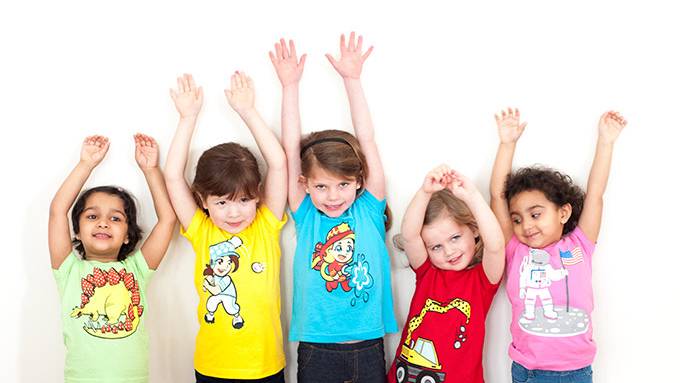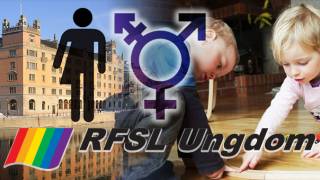The End of Boys and Girls: These Companies Are Going to Change How Your Kids Dress
Source: bloomberg.com
Frustrated parents are launching apparel startups to upend gender norms
Ever since Jaya Iyer's daughter was a toddler, she had been fascinated by Saturn and its icy rings. When Swaha turned three, she had a space-themed birthday party. But when her mom went to find clothes with space images for Swaha, she couldn't find any. They were all in the boys section.
So the 41-year-old mother of two, who has a doctorate in fashion merchandising, started her own business called Svaha (which is how her daughter's name is pronounced) to sell clothes that upend gender stereotypes. One shirt features a grinning green stegosaurus, the plates on its back adorned with polka dots. A second comes in a blazing pink hue, with an astronaut planting an American flag on the moon. That one should satisfy her daughter. "She was very upset with me for not ever buying her anything with astronauts on it," Iyer says. "Then she started telling me: 'I want a ninja on my shirt.'"
Svaha is one of several startups that have emerged in recent years with the goal of changing the standards that govern what kids wear. These upstarts aren't looking to replace current kid's apparel entirely. Instead, their founders say they want to provide children with more options. Handsome in Pink says it's all right for boys to wear pink and purple. BuddingSTEM offers science-themed garb for girls. Perhaps the buzziest label is Princess Awesome, which raised more than $200,000 in a successful Kickstarter campaign, showing demand for pirate-themed dresses and girl's apparel covered in the symbol for pi. Most of the ventures remain in early stages as online-only entities using crowdfunded or bootstrapped cash to sell small numbers of shirts or dresses.
Several of the startups share a common origin: They were borne out of parental frustration with major retailers. Simply shopping in the opposite gender's section isn't the answer, these parents say. Cultural norms mean that as kids get older, designating certain items as male or female can confuse and frustrate them. A girl may not want to wear something designated for boys, and vice-versa.
"Most kids and parents are going to the big retailers and seeing all these messages of what its means to be a boy or a girl," says Sharon Choksi, co-founder of clothing line Girls Will Be. Choksi's daughter Maya, now 10, never liked sparkles or "feminine" colors, so the Choksis would shop for Maya in the boys' section. As Maya got older, Choksi worried that "boy" and "girl" labels would unnecessarily upset her daughter.
Choksi, from Austin, started selling girl's shirts in 2013 before expanding into hoodies and shorts. In an effort to encourage girls to move around freely, the fit of Girls Will Be tops fall somewhere between a traditional, fitted girl's shirt and the boxy, looser fit typically marketed to boys. One design reads, “bold, daring, fearless, adventurous, so many things,” while another features a silhouette of a girl doing a flying sidekick. Choksi wants her clothes to fill a gap left open by big companies. "When are the big retailers going to wake up and realize that not all girls are the same and not all boys are the same?" she asks.
In Seattle, Martine Zoer had similar experiences with her sons. She grew tired of her boys, now four and seven, being pushed merchandise featuring designs of dinosaurs and trucks. In 2014, she founded Quirkie Kids, a label devoted to gender-neutral clothes. "There's nothing wrong with pink or girls liking pink," Zoer says. "But if we only offer them that choice, there's something wrong with that."
“There’s nothing hardwired in our brains that says pink is for girls and blue is for boys,” says Lise Eliot, a neuroscientist at the Chicago Medical School at Rosalind Frank University and author of Pink Brain, Blue Brain: How Small Differences Grow Into Troublesome Gaps—and What We Can Do About It. It’s purely a cultural phenomenon. By the time children are toddlers, Eliot says, boys start rejecting pink because they realize it may diverge from what's expected.
These apparel choices can have enduring repercussions by affecting kids' interests and long-term goals. For instance, since most female clothes are more fitted, they often double as restraints, Eliot says, pushing girls away from physical activities. Kids' play habits matter, because they affect development and ultimately, even what career they end up embracing. If a girl is tugged away from liking outer space by societal pressures, she probably won't veer toward an aerospace profession later in life. If a boy is discouraged from playing with dolls and wearing bold clothes, they may not want to get into fashion design one day. "They see it's the boys with the rocket ships and the girls with the pretty flowers," adds Eliot.
At major retail outlets such as Children's Place and Gymboree, there are few, if any, options for the girl who loves dinosaurs or football. Same goes for the boy who loves unicorns and hearts. Much of the merchandise is as stereotyped as can be: a T-Rex playing football in the boys section; a shirt that reads "I ❤ My B.F.F. More Than Shoes" in the girls section. A representative for Children's Place declined to comment on how it decides what designs and colors to sell boys and girls, and representatives for Gymboree did not respond to a request for comment.
Big retailers are typically focused on quantity, so until enough shoppers demand clothes that don't fall along traditional lines, not much will change, says Patty Leto, senior vice president of childrens' wear at the Doneger Group, a trend intelligence firm. "Pink is always going to sell for girls and blue is always going to sell for boys, no matter what is going on out there with small labels," she says. In the end, it's up to the parents. "The consumer is the ultimate voter here," she says.
Take Lands' End, which in 2014 found itself under attack by angry shoppers when New Jersey mom Lisa Ryder wrote a letter decrying stereotypes in its clothing selection. Flipping through a catalog, Ryder's daughter loved shirts with planets and dinosaurs, though they were clearly marked for boys. When it was suggested to Ryder by a Facebook commenter that she simply purchase a boy's shirt, she responded with vigor. "The problem is that your recent catalog copy and product offerings strongly promote the gender stereotypes that young boys are smart and mighty and young girls are adorable," she wrote. "Simply buying my daughter one of your 'boy shirts' is not the answer because it perpetuates the idea that science is a boy thing that she happens to be participating in." Lands' End decided to release new science-themed shirts for girls.
For the giants of the clothing world, it's an exercise in figuring out what will sell. For the budding brands, it's less a race for revenue than a mission to make a difference. "Everybody's really supportive of each other, rather than being competitive," Zoer, the Quirkie Kids founder, says of the community of new brands. "We're all sort of in this together."
Source: bloomberg.com






















